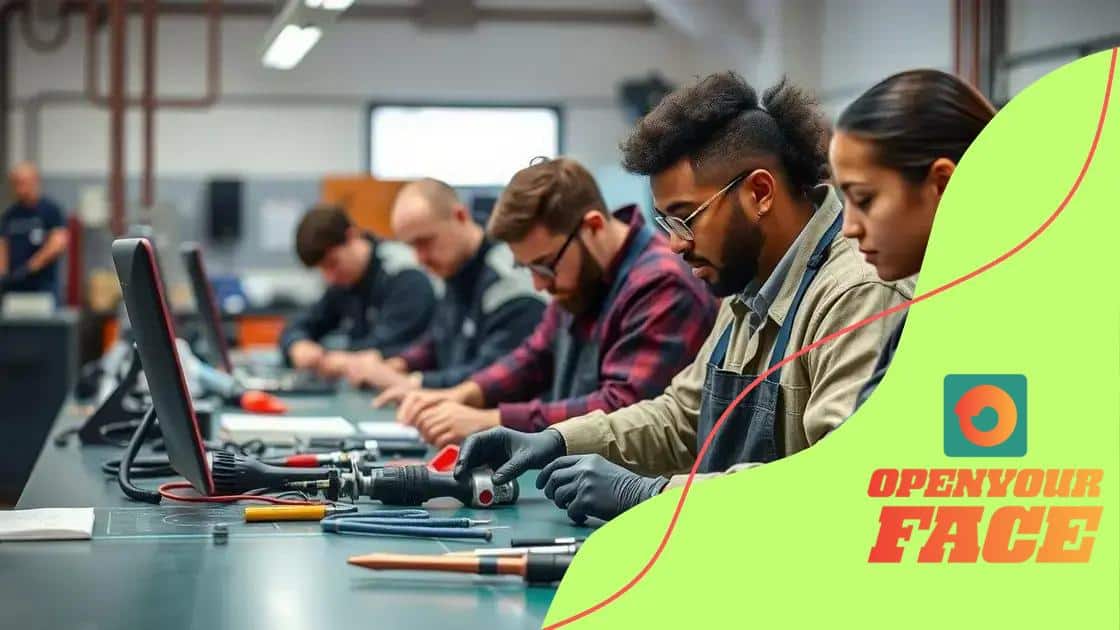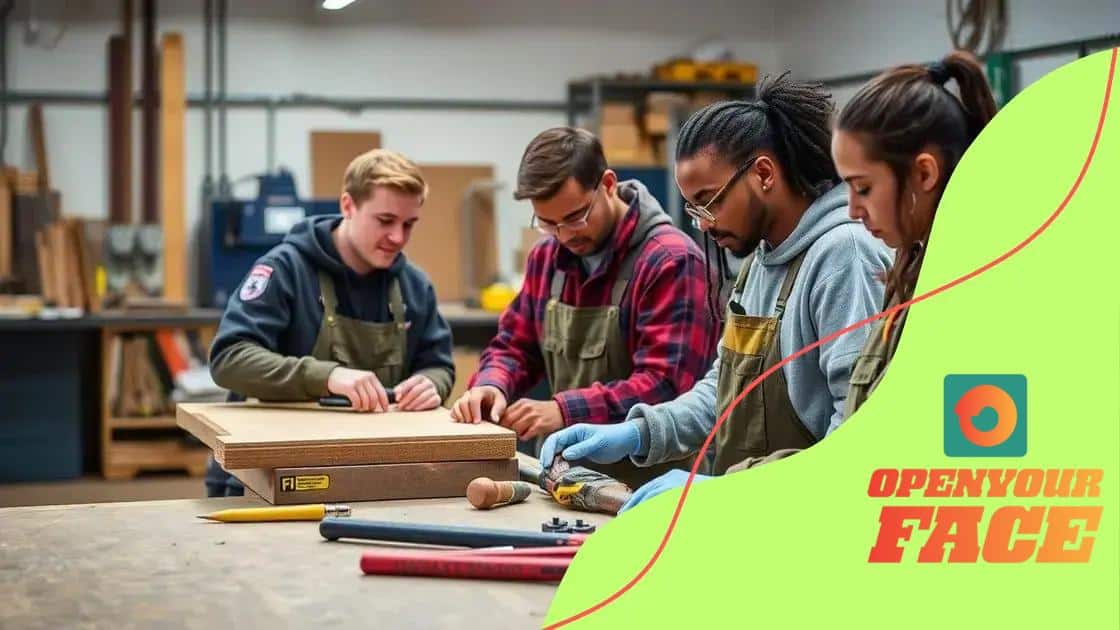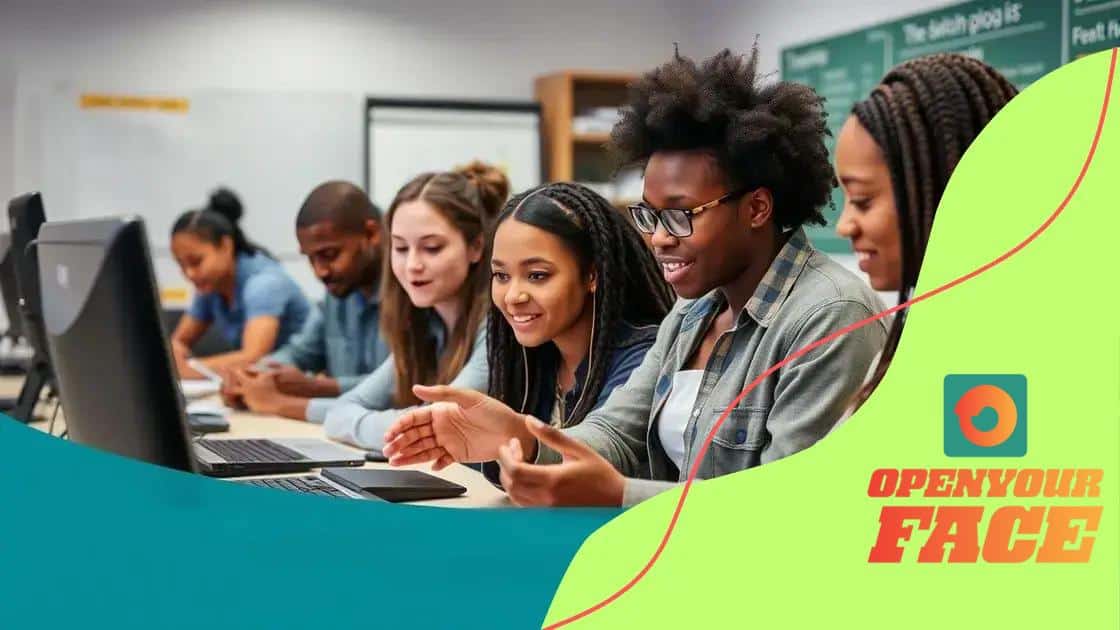Innovations in vocational training for skilled workers

Innovations in vocational training enhance skill development through hands-on experiences, industry partnerships, and technology-driven solutions, preparing students for real-world challenges and increasing job readiness.
Innovations in vocational training for skilled workers are changing the landscape of education and employment. Have you ever wondered how advancements in technology and methods shape the way skills are taught? In this article, we’ll delve into how these innovations create better opportunities for workers.
The role of technology in vocational training
The role of technology in vocational training is vital for preparing students for the modern workforce. It not only makes learning more engaging but also equips students with real-world skills they need. In today’s world, technology can enhance how skills are taught and learned, bridging the gap between theory and practice.
Interactive Learning Tools
Utilizing interactive learning tools is one way technology improves vocational training. These tools provide an immersive experience, allowing students to engage with materials actively. Some effective tools include:
- Virtual simulations to mimic real-life scenarios
- Online classrooms for flexible learning
- Mobile apps for skills practice on-the-go
Additionally, technology assists educators by providing data on student performance. This data helps tailor training to individual needs, ensuring that all learners progress at their own pace.
Industry-Relevant Software
Another important aspect is the use of industry-relevant software. Vocational training programs often incorporate specific software tools used in various fields. This hands-on experience prepares students for what they will encounter in their jobs. For instance, using design software in engineering classes helps students become proficient before even entering the workforce.
Tech-based learning is not just about software; it also embraces concepts like remote learning. With advancements in internet connectivity, students can access training from anywhere. This flexibility opens doors for learners who might not have previously enrolled in traditional vocational programs.
By integrating these technologies into training programs, educational institutions can ensure students are ready for the future. As technology continues to evolve, so will the opportunities for those engaging in vocational training. The outcome is a workforce that is skilled, adaptable, and prepared to meet the challenges of tomorrow.
Benefits of hands-on experience in skilled trades

Hands-on experience in skilled trades offers numerous benefits that enhance learning and career readiness. Engaging in practical activities helps students grasp concepts more effectively. When learners can physically apply their skills, they retain information better and build confidence in their abilities. This real-world experience is particularly important in fields like plumbing, electrical work, and carpentry.
Enhanced Skill Development
Participating in hands-on training allows students to develop their skills efficiently. They learn through trial and error, which is essential for mastering technical tasks. Moreover, students can refine their techniques when they practice in a controlled environment. This environment encourages creativity and innovation as learners experiment with different methods.
- Improves problem-solving abilities
- Increases adaptability in various situations
- Encourages teamwork and collaboration
Such experiences often foster a deeper understanding of the tools and materials involved in various trades. As students gain expertise, they become more competitive in the job market.
Real-World Applications
Another significant benefit is the connection to real-world applications. When students engage in hands-on projects, they see how their technical skills translate into practical solutions. This connection helps them understand the importance of their training.
Additionally, working with experienced professionals during practical sessions exposes students to industry standards and best practices. They learn what is expected in the workplace, making their transition from school to work smoother. The experience not only prepares them for their careers but also instills a sense of professionalism.
Ultimately, hands-on experience bridges the gap between theoretical knowledge and practical skill. By offering students opportunities to apply what they’ve learned in real-life settings, educational programs can produce highly skilled workers ready to meet the demands of the industry.
Industry partnerships enhancing vocational education
Industry partnerships play a crucial role in enhancing vocational education. These collaborations bring together educational institutions and employers to create a more effective learning environment for students. By working together, they ensure that training programs meet the real needs of the job market. This synergy helps students gain the skills that employers are looking for.
Tailored Training Programs
One of the main benefits of industry partnerships is the ability to create tailored training programs. Industry experts can provide insights into the specific skills and knowledge required in their fields. This information allows educators to design curricula that focus on relevant content, ensuring students are well-prepared for their future careers.
- Incorporating real-world scenarios into lessons
- Utilizing updated tools and technology
- Providing access to internships and job placements
These enhancements create a more effective learning experience, making vocational education relevant and practical.
Access to Resources
Partnerships with industries also grant students access to valuable resources. Companies can offer equipment, funding, and even personnel to support training programs. This access not only improves educational quality but also allows students to work with the latest technology in their field. Hands-on experience with current tools is invaluable and makes students more marketable.
Moreover, students who engage in these partnerships often receive mentorship from industry professionals. This guidance helps them navigate their career paths while providing networking opportunities that can lead to future employment.
By collaborating effectively, educational institutions and industries can bridge the gap between training and employment. This partnership lays the foundation for a skilled workforce ready to tackle the challenges in their chosen fields.
Emerging trends in skills development

Emerging trends in skills development are reshaping how individuals prepare for the workforce. As technology advances and job requirements change, new methods of learning and training are being introduced. Staying updated on these trends is crucial for learners and educators alike.
Personalized Learning Experiences
One significant trend is the shift towards personalized learning experiences. Tailoring education to meet individual needs allows learners to progress at their own pace. This can be accomplished through:
- Adaptive learning technologies that analyze a student’s strengths and weaknesses
- Customized training plans based on career goals
- Flexible course offerings that fit different learning styles
This approach ensures that all students can achieve their full potential and gain relevant skills for their future careers.
Focus on Soft Skills
Another emerging trend is the increasing emphasis on developing soft skills. Employers are looking for candidates who possess not just technical abilities but also strong interpersonal skills. Skills such as communication, teamwork, and critical thinking are becoming essential. Programs are now incorporating soft skills training alongside technical education to create well-rounded candidates.
As workplaces evolve, being adaptable and able to work collaboratively will set individuals apart. This focus on soft skills prepares students for real-world challenges they will face in their careers.
Furthermore, online platforms and courses are becoming more popular, enabling learners to access high-quality content worldwide. These digital resources provide flexibility and a broader range of subjects, meeting the diverse needs of learners. This transformation in skills development is leading to a more capable workforce that is ready for future demands.
Success stories from innovative programs
Success stories from innovative programs highlight the positive impact of modern approaches in vocational training. These programs have transformed lives and careers by using creative methods to deliver education. Through partnerships with industries and the integration of technology, students are achieving remarkable outcomes.
Real-World Impact
One example is a program that connects students with local businesses. This partnership provides hands-on training in a real-world environment. Students gain experience and confidence while working alongside professionals. Many graduates from this program have secured jobs in their fields soon after completing their studies.
- Access to practical skill development
- Networking opportunities with industry leaders
- Higher job placement rates for graduates
These elements contribute to the program’s overall success, demonstrating how innovation can lead to impactful vocational education.
Technology-Driven Solutions
Another success story comes from a vocational school that implemented virtual reality (VR) training. By using VR simulations, students can practice their skills in safe settings. This immersive experience not only enhances their technical competencies but also helps improve problem-solving abilities.
Students have reported feeling more prepared for real-life challenges after completing their training. The use of technology fosters a deeper understanding of complex concepts. As a result, graduates from these programs are better equipped to meet industry demands.
Innovative programs like these are shaping the future of vocational training. They create pathways for success, ensuring that students are ready to excel in their careers. By focusing on practical, hands-on experiences and integrating modern technology, these programs set new standards in skilled workforce development.
| Key Takeaways | Details |
|---|---|
| 🚀 Innovation | Modern methods boost learning. |
| 🤝 Partnerships | Industry ties enhance practical training. |
| 🛠️ Hands-on Experience | Real-world applications cement knowledge. |
| 🎓 Skills Development | Emerging trends focus on adaptability. |
| 🌍 Global Access | Online resources broaden learning opportunities. |
FAQ – Frequently Asked Questions about Innovations in Vocational Training
What are the key benefits of hands-on experience in vocational training?
Hands-on experience enhances skill development, builds confidence, and prepares students for real-world job scenarios.
How do industry partnerships improve vocational education?
Industry partnerships create tailored training programs and provide students with access to resources, real-world experience, and job placement opportunities.
What emerging trends are shaping skills development today?
Current trends include personalized learning experiences, a focus on soft skills, and technology-driven solutions such as online training and virtual simulations.
How can students access innovative vocational programs?
Students can access innovative programs through community colleges, vocational schools, and online platforms that offer flexible learning options.






